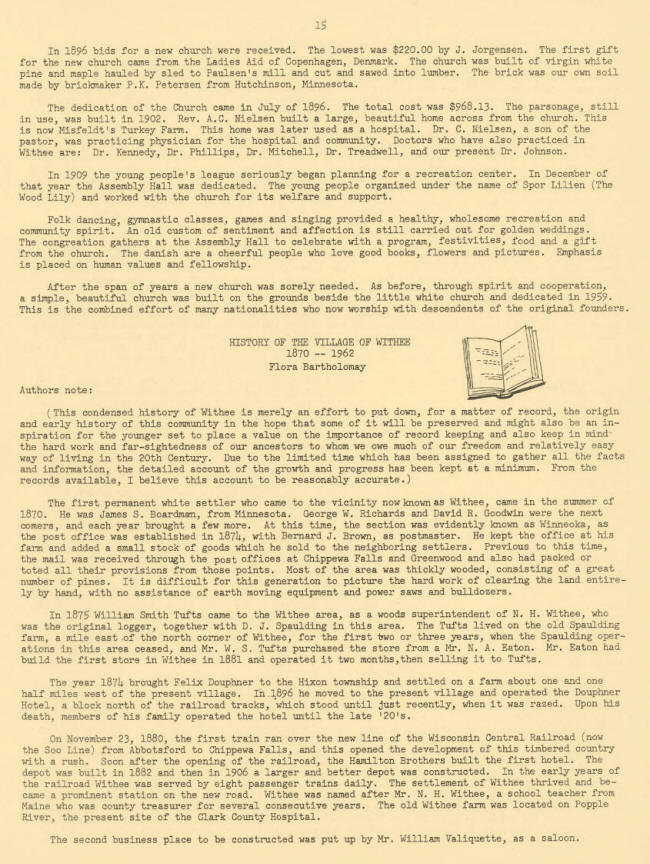|
[Memory
Trails Index]
Transcription
Janet Schwarze
gIn 1896 bids for a new
church were received. The lowest was $220.00 by J. Jorgensen. The first gift for
the new church came from the Ladies Aid of Copenhagen, Denmark. The church was
built of virgin white pine and maple hauled by sled to Paulsen’s mill and cut
and sawed into lumber. The brick was our own soil made by brick maker P. K.
Petersen from Hutchinson, Minnesota.
The dedication of the Church came in July of 1896. The total cost was $968.13.
The parsonage, still in use, was built in 1902. Rev. A. C. Nielsen built a
large, beautiful home across from the church. This is now Misfeldt’s Turkey
Farm. This home was later used as a hospital. Dr. C. Nielsen, a son of the
pastor, was practicing physician for the hospital and community. Doctors who
have also practiced in Withee are: Dr. Kennedy, Dr. Phillips, Dr. Mitchell, Dr.
Treadwell, and our present Dr. Johnson.
In 1909 the young people’s league seriously began planning for a recreation
center. In December of that year the Assembly Hall was dedicated. The young
people organized under the name of Spor Lilien (The Wood Lily) and worked with
the church for its welfare and support.
Folk dancing, gymnastic classes, games and singing provided a healthy, wholesome
recreation and community spirit. An old custom of sentiment and affection is
still carried out for golden weddings. The congregation gathers at the Assembly
Hall to celebrate with a program, festivities, food and a gift from the church.
The Danish are a cheerful people who love good books, flowers and pictures.
Emphasis is placed on human values and fellowship.
After the span of years a new church was sorely needed. As before, through
spirit and cooperation, a simple, beautiful church was built on the grounds
beside the little white church and dedicated in 1959. This is the combined
effort of many nationalities who now worship with descendents of the original
founders.
HISTORY OF THE VILLAGE OF WITHEE
1870 -— 1962
Flora Bartholomay
Authors note:
(This condensed history of Withee is merely an effort to put down, for a matter
of record, the origin and early history of this community in the hope that some
of it will be preserved and might also be an inspiration for the younger set to
place a value on the importance of record keeping and also keep in mind the hard
work and far-sightedness of our ancestors to whom we owe much of our freedom and
relatively easy way of living in the 20th Century. Due to the limited time which
has been assigned to gather all the facts and information, the detailed account
of the growth and progress has been kept at a minimum. From the records
available, I believe this aooount to be reasonably accurate.)
The first permanent white settler who came to the vicinity now known as Withee,
came in the summer of 1870. He was James S. Boardman, from Minnesota. George W.
Richards and David R. Goodwin were the next comers, and each year brought a few
more. At this tine, the section was evidently known as Winneoka, as the post
office was established in 1874, with Bernard J. Brown, as postmaster. He kept
the office at his farm and added a small stock of goods which he sold to the
neighboring settlers. Previous to this time, the mail was received through the
post offices at Chippewa Falls and Greenwood and also had packed or toted all
their provisions from those points. Most of the area was thickly wooded,
consisting of a great number of pines. It is difficult for this generation to
picture the hard work of clearing the land entirely by hand, with no assistance
of earth moving equipment and power saws and bulldozers.
In 1875 William Smith Tufts came to the Withee area, as a woods superintendent
of N. H. Withee, who was the original logger, together with B. J. Spaulding in
this area. The Tufts lived on the old Spaulding farm, a mile east of the north
corner of Withee, for the first two or three years, when the Spaulding
operations in this area ceased, and Mr. W. S. Tufts purchased the store from a
Mr. N. A. Eaton. Mr. Eaton had build the first store in Withee in 1881 and
operated it two months, then selling it to Tufts.
The year 18714 brought Felix Douphner to the Hixon township and settled on a
farm about one and one half miles west of the present village. Ih.1896 he moved
to the present village and operated the Douphner Hotel, a block north of the
railroad tracks, which stood until just recently, when it was razed. Upon his
death, members of his family operated the hotel until the late ‘20’s.
On November 23, 1880, the first train ran over the new line of the Wisconsin
Central Railroad (now the Soo Line) from Abbotsford to Chippewa Falls, and this
opened the development of this timbered country with a rush. Soon after the
opening of the railroad, the Hamilton Brothers built the first hotel. The depot
was built in 1882 and then in 1906 a larger and better depot was constructed. In
the early years of the railroad Withee was served by eight passenger trains
daily. The settlement of Withee thrived and became a prominent station on the
new road. Withee was named after Mr. N. H. Withee, a school teacher from Maine
who was county treasurer for several consecutive years. The old Withee farm was
located on Popple River, the present site of the Clark County Hospital.
The second business place to be constructed was put up by Mr. William
Valiquette, as a saloon.
[Next]
[Memory
Trails Index]
|
